The Now-to-New practitioner uses mind, body and spirit to transcend the mundane, imagine what could be, bring it into being and enrich the world with value, meaning and joy.
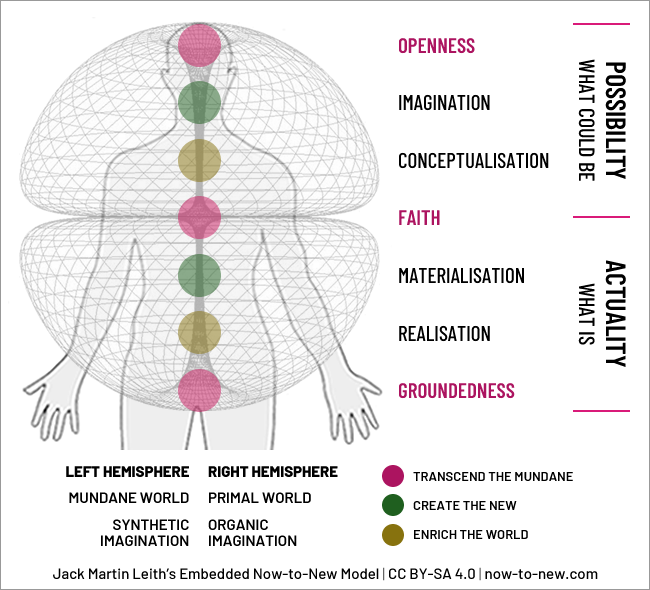
Dual torus image sourced from Michael C Grasso and decoloured.
The Now-to-New practitioner’s mind
Mind is represented by the horizontal plane.
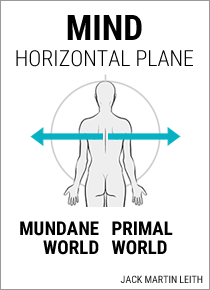
The comparison chart below is based in part on the work of Iain McGilchrist, a psychiatrist, neuroscience researcher and writer best known for his theory of how the brain’s hemispheres differ in the way they attend to the world.
His theory supersedes the debunked yet still prevalent split-brain theory developed in the 1960s by Roger Sperry and others.
Iain McGilchrist talks about two worlds without naming them. My names are mundane world (everyday world, default reality) and primal world (view rationale).
| MUNDANE WORLD Brought forth by brain’s left hemisphere | PRIMAL WORLD Brought forth by right hemisphere |
|---|---|
| In this world: We seek certainties. Everything can be named, described and situated on the arrow of time. Abstraction, reductionism and thingification prevail. Our lives are experienced at one stage removed, like watching a video rather than the actual performance. We know the map, not the territory Generative thought and action are constrained by a barrage of rules, norms, mores, codes, beliefs, dogmas, narratives and ideologies. We are domesticated. We are separate from nature. Our imagination is synthetic. | In this world: We imagine possibilities. There are no names, no descriptions and no arrow of time, only the present moment. As soon as we name something it becomes a thing and therefore part of mundane world. “The Tao that can be told is not the eternal Tao.” Tao Te Ching We experience life in the raw: visceral, untamed, unfiltered, uncodified and unconceptualised. Our thinking is all-embracing. We are part of nature. Our imagination is organic. |
Two forms of imagination
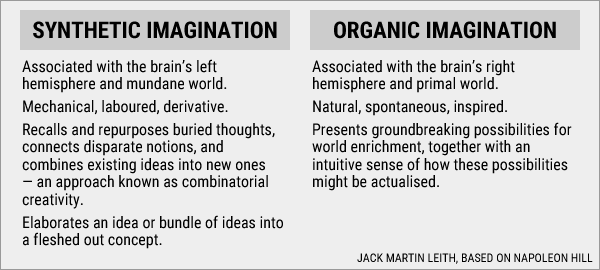
Read more
Iain McGilchrist and his theory of brain hemisphere differences
Jill Bolte Taylor, a neuroscientist who experienced her brain’s left hemisphere shutting down
The two forms of imagination: synthetic and organic
The Now-to-New practitioner’s body
Body is represented by the vertical plane.
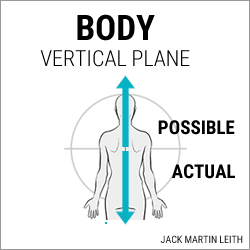
Each of the seven powers appearing in the table below is associated with a particular part of the body.
The powers of Openness, Imagination and Conceptualisation are concerned with possibility.
The powers of Materialisation, Readiness and Groundedness are concerned with converting possibility into actuality.
| POWER | SUPERPOWER | CATEGORY | PURPOSE | ASSOCIATION |
|---|---|---|---|---|
| OPENNESS | Transcend the mundane | State | Connecting to the nonmaterial realm | Crown |
| IMAGINATION | Enrich the world | Creative faculty | Imagining a world enrichment possibility and conceiving a high potential idea | Third eye ¹ |
| CONCEPTUALISATION | Create the new | Creative faculty | Devising something that will generate the imagined value, meaning and joy | Throat |
| FAITH | Transcend the mundane | State | Connecting to the wellspring of love, experienced as a heartfelt desire to enrich the world with value, meaning and joy | Heart |
| MATERIALISATION | Create the new | Creative faculty | Giving the creation tangible form and introducing it to the world at large | Navel |
| REALISATION | Enrich the world | Creative faculty | Bringing the creation to fullness and realising its value generation potential | PC muscles ¹ |
| GROUNDEDNESS | Transcend the mundane | State | Connecting to the material realm | Tailbone |
1. The mythical ‘third eye’ is located between the eyebrows. The PC (pubococcygeus) muscles — we all have two — are the ones for controlling urine flow.
The Now-to-New practitioner’s spirit
To be spirited is to have a force that brings you up, that animates you out of inertia.
Shabaka Hutchings, jazz musician and composer, in The Guardian | View
Spirit is represented by the heart, the seat of Faith, situated at the intersection of the horizontal and vertical planes.Spirit is the animating force throughout creation. An unseen force that is life, the divine, the nagual, the light. To live a spiritual life is to identify oneself as the animator of creation, rather than as creation.
Allan Hardman | Visit website
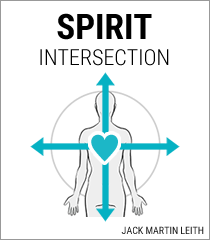
The heart is where we experience our intent (life purpose, pure love, commitment to selfless service) as an unceasing desire to enrich the world with value, meaning and joy.
Faith is not used in the religious sense but rather with the meaning conveyed in the passages below.
Faith is a critical but curious mind’s readiness to adopt a reality model (even if provisionally) for which there is less than absolute, empirical proof.
Jay B. Gaskill, The Dialogic Imperative
Faith is an existential commitment of the heart, a way of life, a set of behaviors and emotional responses woven into every hour of everyday life — expressed through constant choices both when alone and in social situations.
Peter A. Georgescu, Faith isn’t irrational, but beliefs may be, on Huffington Post | Peter A. Georgescu is Chairman Emeritus of advertising agency network Young & Rubicam, Inc.
Transcending the mundane
Transcend means to rise above or go beyond the limits of. It also means to triumph over the negative or restrictive aspects of. It does not mean to shun.
The Now-to-New practitioner transcends the mundane by:
- Feeling connected to the nonmaterial realm (power of Openness)
- Feeling connected to the wellspring of love (power of Faith)
- Feeling connected to the material realm (power of Groundedness)
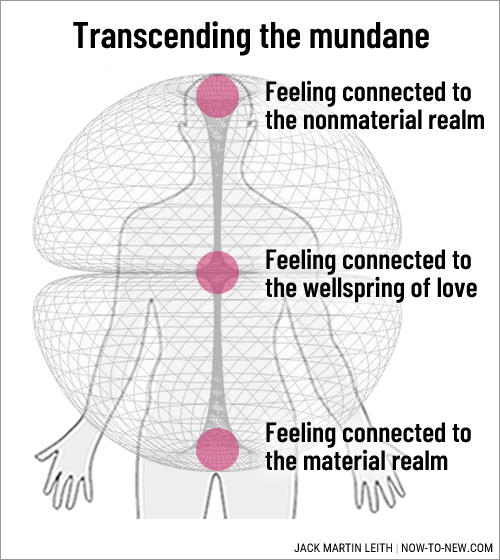
In this transcendent state of being, the creative faculties of Imagination, Conceptualisation, Materialisation and Realisation (of potential) are fully activated and ready to be deployed.

Mundane world.
Primal world.
Synthetic imagination.
Organic imagination.
Each has an equal part to play.
Primal world is not the place to be when completing your tax return or shopping for groceries.
Continue reading
Now-to-New
The evolution of the Now-to-New project model
How the term Now-to-New came into being
Now-to-New: how it began, what came next and current status
Readiness work sets the Now-to-New project in motion
The seven kinds of Now-to-New work
Some open source and proprietary Now-to-New methods
The three Now-to-New action modes — Part 1
Related topics
Iain McGilchrist and his theory of brain hemisphere differences
Jill Bolte Taylor, a neuroscientist who experienced her brain’s left hemisphere shutting down
The two forms of imagination: synthetic and organic
General
Search the site
Not case sensitive. Do not to hit return.